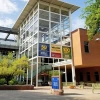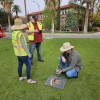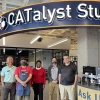Discovering the Unique Broadcast Information Technologies at AZPM
A discovery series on the diversity and uniqueness of technology services at UArizona

Arizona Public Media (AZPM) is home to the University of Arizona’s and Southern Arizona’s Public Broadcast System (PBS) and National Public Radio (NPR) affiliate. As an exceptional university entity, AZPM operates three television programs on two TV stations, four radio programs (NPR 89.1, Classical 90.5, Jazz 89.1 HD2 and BBC News) and a number of digital streaming services. These services encompass 24/7 The dynamic nature of AZPM’s live public media service renders the technologies overseen by its IT staff both distinctive and intriguing to explore.
Ian MacSpadden, AZPM’s chief technology officer, explains that most of the staff at AZPM have some level of technology experience, from capturing and distributing media content on video or audio, to editing that content on computer-based systems. The content is then distributed over the IP based links and networks. Ian uses the term “broadcast information technology engineer,” to best describe the work done in his industry. “What used to be baseband equipment designed just for radio or television, today is plugged into an RJ45 jack on the wall communicating with digital devices throughout the facility, to remote transmission sites and then out to the public. This broadcast technology and business model is layered on top of IT best practices and resources provided by the University."
An example is when staff are producing a news story for the Arizona Illustrated program. “When our videographers go out into the field, they record files to a drive on their camera. They’re no longer running analog video tape or film formats that used to exist.” The memory cards are then taken to the station and are plugged into a computer that ingests the files into a media management system. “All the digital assets that are ingested go into a shared network platform where they can be accessed by multiple staff members.” The content might be used by staff who are crafting a promotional piece for it, or a producer who’s actually editing the broadcast version, or an editor who might need a piece of the content for an entirely different story.
When asked about the various distribution outlets, Ian explains that radio and TV content is streamed live from within the studio, and a higher quality of content distribution goes out on YouTube for streaming. Then there is the content that is broadcast over the air. Currently AZPM broadcasts ATSC 1, which is the traditional broadcast standard that the nation uses to send out digital signals. Later this spring, AZPM is excited to be converting to the newest broadcast standard ATSC3 NextGen TV, which is IP based, on May 23.
The broadcast technologies used (and supported by Ian and his staff) include very sophisticated timing systems that require frame accurate timing. “At 30 frames per second, being off by one frame a second can add up to multiple frames, which become multiple seconds, which creates overlap or cut off.” An example of the latency difference between traditional IT and broadcast IT is sending and receiving email. “If your email gets to you in 2 minutes or 10 minutes, that is the latency of the network and is considered minimal delay by most. If you are watching a movie and it buffers a bit, it’s annoying and people notice."
In broadcasting, precision is paramount. Every aspect, from playback to transfer to broadcast, must occur at a frame-accurate level. This requires special systems and applications that exist above the IT layer throughout the facility. “Consider a scenario with five cameras sending IP video content, each with a unique time stamp on it, needing to arrive to the video switcher in the exact same order to make sure there is no video jittering. Achieving this demands a super low latency network with non-blocking switches that exceed the standard IP network used for general office applications. The result? The frames run really fast and accurate.”
Ian defines “really fast” as higher level processing with more bandwidth. Most facilities on campus run on a 1 gigabit Ethernet (GbE) network backbone. AZPM runs on a 10GbE backbone currently and will be moving to 25GbE to 100GbE in their new facility, UA TechPark at The Bridges, due to open in late 2025.
When AZPM moves into their new facility, they will become the point-of-presence (POP) and the demarcation point (the point in the network where the responsibility of the service provider ends), for all of the facility’s future bandwidth needs. There will be multiple generators and UPS systems to support the 24/7 operations required for the station and research community. According to Ian, “This is necessary for 4K video which actually becomes 12GbE per second of video; it won’t fit on a 10GbE network. For this reason, our network has to be a little more robust.”
AZPM also needs extremely high bandwidth in and out of their location. “We produce live radio streams and live television streams that come from our facility. When you aggregate that together, you can imagine we have 10 to 20 gigabits per second of bandwidth leaving our building 24 hours a day, 7 days a week."
With the new AZPM facility, there will be multiple internet providers connecting into their building with multiple options including IP microwave dishes to maintain continuous broadcasting capability in an emergency. As host to the Emergency Alert System (EAS) and WARN system, (AMBER/Silver/WX alerts), AZPM must meet FCC requirements for ensuring they can broadcast emergency information out to their television networks and radio transmitters which feed your cellular phone via cell towers to inform you in an emergency.
Ian and his team of 22 technicians and creative staff have been working closely with the UITS networking team to design the network connectivity and redundancy for their new building as architectural plans come to fruition. He is quick to say that Vince Capuano’s Estimating and Engineering team and UITS networking technicians have the expertise for design and build of the IP backbone, firewalls and network for a next generation facility. “They oversee supercomputer operations and know high speed networks.” UITS will continue supporting the computers and internet needs in the next generation building. Ian’s staff have the expertise to design and build out the broadcast equipment layer, and both teams are excited about collaborating and creating a new seamless, technology-rich facility that benefits the University and the Southern Arizona community.

Broadcast IP Video Systems require precision and redundancy. Every frame of video (and IT encapsulation packets) has to be timed to arrive to its destination in the correct order to be reassembled in order. Precision Timing Protocol (PTP), dual spine and leaf architecture along with an orchestration system are all required to make this ecosystem function flawlessly.










